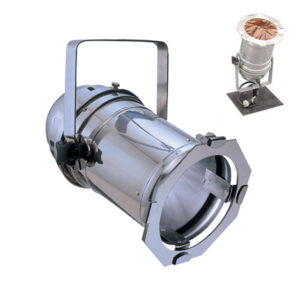 PAR CAN LIGHTING
PAR CAN LIGHTING
The PAR can is perhaps the most widely used light for concerts, nightclubs and touring productions. PAR cans come in a variety of sizes and shapes; from the minuscule PAR16 to the 1000 watt PAR64. But what the heck is a PAR can, anyway? How did it get that name? And just why are they so popular?
PAR is an acronym for parabolic aluminized reflector and is used to designate a sealed-beam lamp similar to the headlight in an automobile. PAR lamps are differentiated according to their diameter, which is measured in eighths of an inch. Therefore, a PAR64 is eight inches in diameter (64/8 = 8) and a PAR38 has a diameter of four and three-quarter inches (38/8 = 4.75). PAR lamps are available in an assortment of wattages and beam spreads as well. For example, a PAR56 lamp may be purchase at 300 or 500 watts, and each wattage is available in Narrow Spot, Medium Flood or Wide Flood.
The PAR can is the lamp housing that safely holds the lamp and any color media (gel) in place. The can also has a mounting bracket that allows it to be bolted to a light bar or truss or by use of a pipe clamp…well, clamped to a pipe. In some smaller-budget houses the PAR can is literally a can, usually an old coffee can that has been fitted with a ceramic lamp socket and spray-painted black. However, the relatively low cost of PAR cans these days has made this practice uncommon in most theaters.

LED Lighting
An ultra bright LED panel with 210 10mm LED’s (70 red, 70 green, 70 blue).
This FLOOD panel features a 55 degree beam spread.
Stage Ape LED light
This LED panel with all LED’s on at 100% puts out 2,820 LUX at 1 meter.
Modes include: sound active with built-in mic, stand alone color change with speed options, strobe, master/slave and DMX.
7 channel DMX.
Power consumption 50 watts. Comes with power cord. 100,000 hr LED’s.
Unit size 13″ x 7″ x 4″ and weighs 4.4 Lbs.

